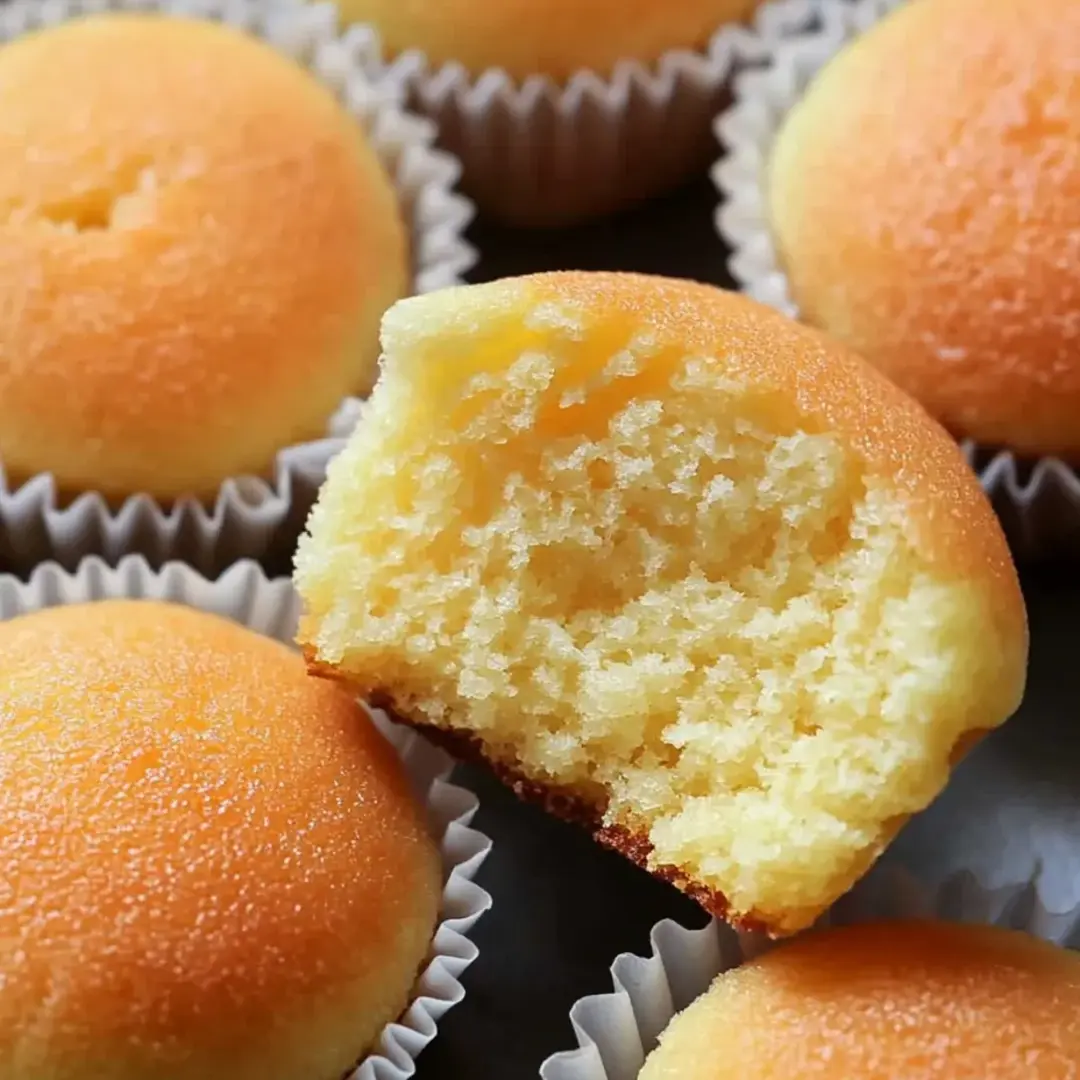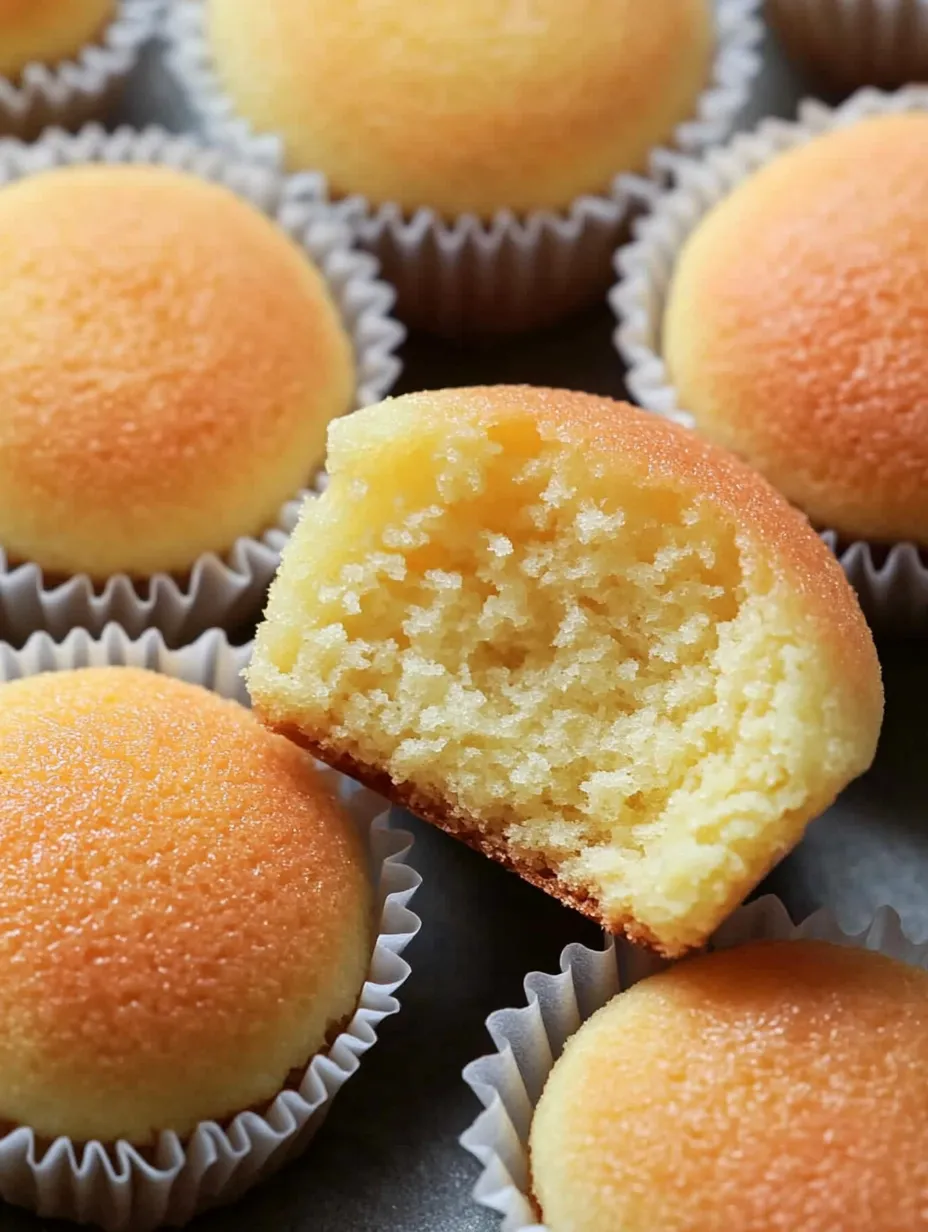 Pin it
Pin it
Chinese egg cake takes me back to childhood with its delicate texture and subtle sweetness that somehow manages to be both simple and deeply satisfying. This beloved treat—sometimes called mini Chinese sponge cake or honey cake when sweetened with honey—features a beautifully airy crumb and golden exterior that makes it irresistible as a breakfast indulgence or afternoon snack. The baked version elevates the humble ingredients of eggs, sugar, and flour into something truly special, capturing the essence of traditional Chinese baking while avoiding the slightly raw egg flavor that can sometimes linger in the steamed variations.
I first encountered these delightful little cakes as a young girl, when purchasing cakes from stores was something special. The aroma would drift through the air, pulling me toward the bakery section where these golden treasures waited. After successfully recreating them at home recently, they've become a weekend breakfast staple in my household. The first time my children tried them, their eyes lit up with the same joy I remember feeling all those years ago.
Essential Ingredients
- Eggs: Form the foundation of the cake's structure and richness. Choose fresh eggs at room temperature for maximum volume when beaten. The quality of eggs significantly impacts the final flavor, so select the freshest available.
- Castor sugar: Creates sweetness while dissolving easily into the egg mixture. Its fine texture is crucial for achieving the proper consistency. If unavailable, pulse regular granulated sugar in a food processor until finely ground.
- All-purpose flour: Provides structure while keeping the cakes light. Always sift the flour to remove lumps and incorporate air, resulting in a more delicate texture.
- Vegetable oil: Adds moisture and tenderness to the finished cakes. Use a neutral-flavored oil like canola or sunflower to let the egg flavor shine through.
- Vanilla extract: Enhances the sweet aroma and complements the egg flavor beautifully. Pure vanilla extract offers the cleanest flavor, though artificial works in a pinch.
- Lemon zest: Optional but adds a bright note that balances the richness of the eggs. Choose unwaxed lemons and zest only the yellow outer layer for the best flavor.
 Pin it
Pin it
Detailed Cooking Instructions
- Step 1:
- Prepare your baking environment – Begin by preheating your oven to 350°F (180°C). This moderate temperature allows the cakes to rise evenly without browning too quickly. Position your rack in the middle of the oven for optimal heat distribution. Line a 12-cup mini muffin tin with paper liners, which makes removal easy and adds to the traditional presentation.
- Step 2:
- Master the egg whipping technique – In a large mixing bowl, combine 2 large room-temperature eggs with 40g (3 tablespoons) castor sugar. Begin beating at medium speed to incorporate the sugar, then increase to high speed. This is the most crucial step – continue beating until the mixture becomes very pale, almost white, and has tripled in volume. When you lift the beater, the mixture should fall back into the bowl in a thick ribbon that sits on the surface for several seconds before slowly disappearing. This may take 12-15 minutes with a hand mixer or 4-5 minutes with a stand mixer. Patience here is rewarded with perfectly airy cakes.
- Step 3:
- Remove large air bubbles – Once the proper consistency is achieved, reduce the mixer speed to low and beat for another 30 seconds. This eliminates larger air bubbles that could cause the cakes to collapse during baking. The batter should now have a smooth, silky appearance with a thick, mousse-like consistency.
- Step 4:
- Incorporate the dry ingredients – Sift 50g (approximately ⅓ cup + 1 tablespoon of sifted) all-purpose flour directly over the whipped egg mixture. Sifting is non-negotiable as it prevents lumps and helps maintain the air you've worked so hard to incorporate. Add 15g (1 tablespoon) of vegetable oil around the edge of the bowl rather than directly onto the flour.
- Step 5:
- Fold with precision – Using a flexible silicone spatula, gently fold the ingredients together with a cutting motion through the center, then sweep around the sides and bottom of the bowl. Continue just until no dry flour remains visible – overmixing will deflate the batter and result in dense cakes. The proper folding technique preserves the air bubbles that give these cakes their characteristic lightness.
- Step 6:
- Fill the muffin cups thoughtfully – Transfer the batter to a pouring container with a spout, or use a large spoon to carefully fill each paper liner about ¾ full. Distribute the batter evenly among all cups to ensure uniform baking. Gently tap the filled muffin tin on the counter once or twice to release any large air pockets, but don't overdo it.
- Step 7:
- Bake to golden perfection – Place the muffin tin in the preheated oven and bake for 15 minutes. The cakes are done when they've risen into perfect domes with golden-brown tops and spring back lightly when touched. Avoid opening the oven during the first 10 minutes of baking, as the temperature drop can cause the cakes to sink.
- Step 8:
- Cool with care – Remove the muffin tin from the oven and allow the cakes to cool in the tin for 5 minutes. The slight cooling period helps the cakes set and makes them easier to handle. Then transfer them to a wire rack to cool completely. These cakes are delicious warm, at room temperature, or even slightly chilled.
- Step 9:
- Store properly – Place completely cooled cakes in an airtight container, where they'll remain fresh for up to 3 days at room temperature. For longer storage, refrigerate for up to a week or freeze for up to a month. Always bring to room temperature before serving for the best texture and flavor.
Perfect Pairings and Serving Suggestions
These delicate egg cakes pair beautifully with a variety of beverages. Traditionally, they're enjoyed with Chinese tea – a light oolong or jasmine tea complements without overpowering the subtle egg flavor. For breakfast, I serve them with warm soy milk or rice milk for a complete meal that starts the day on a sweet note. When offering these as an afternoon treat, fresh fruit on the side adds a refreshing contrast to the cakes' sweetness.
 Pin it
Pin it
Scaling the Recipe for Gatherings
One of the beauties of this recipe is how easily it scales for larger gatherings. For a standard 12-cup regular-sized muffin tin, simply double all ingredients (4 eggs, 80g sugar, 100g flour, and 30g oil). The baking time may need to be extended by 3-5 minutes for the larger cakes. When making these for a crowd, I often prepare multiple batches rather than scaling up too dramatically, as maintaining the proper egg-whipping consistency becomes more challenging with very large volumes.
Troubleshooting Common Issues
Even with careful preparation, challenges can arise. If your cakes sink in the middle, the likely culprit is underbaking or opening the oven too early. If they turn out dense rather than fluffy, focus on more thorough egg whipping next time – that truly is the key to success. Cakes that stick to the liners usually indicate the liners weren't properly greased, or the cakes were removed while still too warm. For stubborn sticking, refrigerating the cakes often helps them release more cleanly.
Modern Twists on a Traditional Favorite
While the classic recipe remains my favorite, I occasionally add gentle variations. A teaspoon of matcha powder sifted with the flour creates a beautiful green tea version. During citrus season, orange zest replaces lemon for a subtle variation. For special occasions, adding 1 tablespoon of honey with the sugar creates a more aromatic honey cake variation that children particularly adore.
I discovered that using eggs from my friend's backyard chickens makes a noticeable difference in both color and flavor – the yolks are more vibrant, resulting in a beautiful golden cake. My grandmother always said you can judge a good egg cake by holding it up to the light – a properly made one should have a uniform, fine crumb structure with no large air holes or dense patches.
My final thought on these Chinese egg cakes is that they represent the beautiful simplicity of traditional Chinese baking – transforming humble ingredients into something truly special through technique rather than complexity. Each time I make them, I'm transported back to those childhood moments of pure joy when the aroma of freshly baked cakes would fill the air. There's something deeply satisfying about carrying on this tradition and watching my own family experience that same simple pleasure that has delighted generations before them.
Frequently Asked Questions
- → Why is it important to whip the eggs for so long?
- The extended whipping time (12-15 minutes) is crucial for incorporating air into the eggs, which creates the characteristically light, fluffy texture. The mixture needs to reach the 'ribbon stage' where it falls from the beater in thick ribbons that briefly hold their shape on the surface.
- → What is the purpose of the warm water bath when whipping the eggs?
- The warm water bath gently heats the eggs, allowing them to whip up more quickly and hold more air. This is especially important in colder weather, as eggs at room temperature or colder won't incorporate as much air, resulting in denser cakes.
- → Can I add flavors to this basic recipe?
- Yes, you can add 1/2 teaspoon of vanilla extract or 1 teaspoon of citrus zest for flavor variations. Some versions include a small amount of milk (2-3 tablespoons) for added tenderness. Keep additions minimal to maintain the light texture.
- → Why did my cakes collapse after baking?
- Collapsing usually happens when the eggs aren't whipped enough, the batter is deflated during mixing, or the oven temperature is too low. Be gentle when folding in flour, don't open the oven door during the first 10 minutes of baking, and make sure your oven is properly preheated.
- → How should I store these egg cakes?
- These cakes are best enjoyed fresh on the day they're made. However, you can store them in an airtight container at room temperature for up to 2 days. They will gradually lose their light texture over time. Do not refrigerate as this will dry them out.
